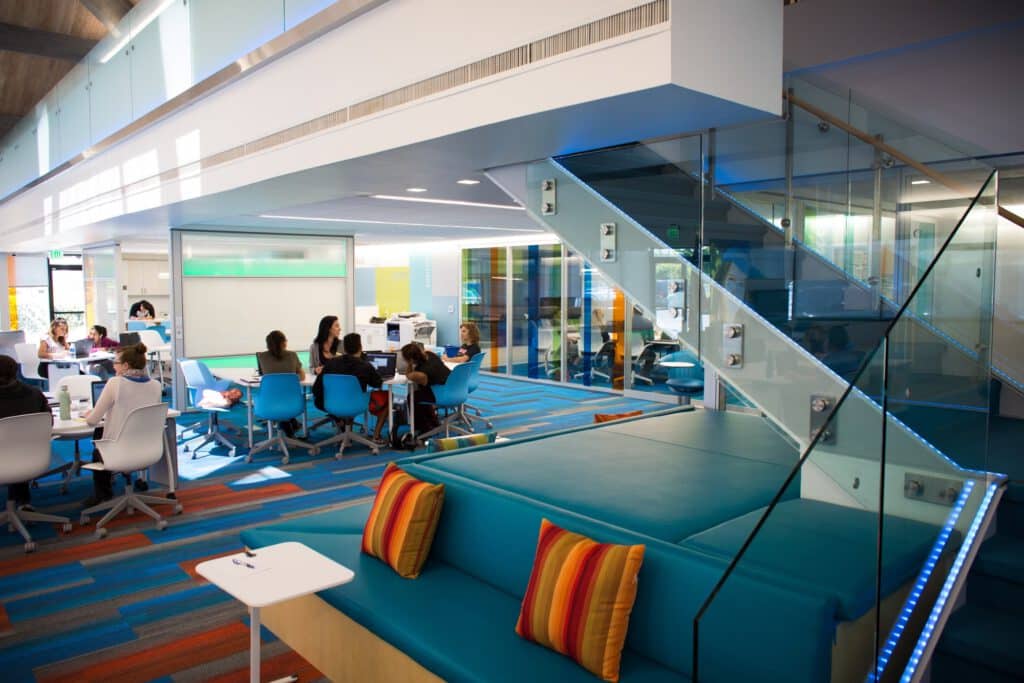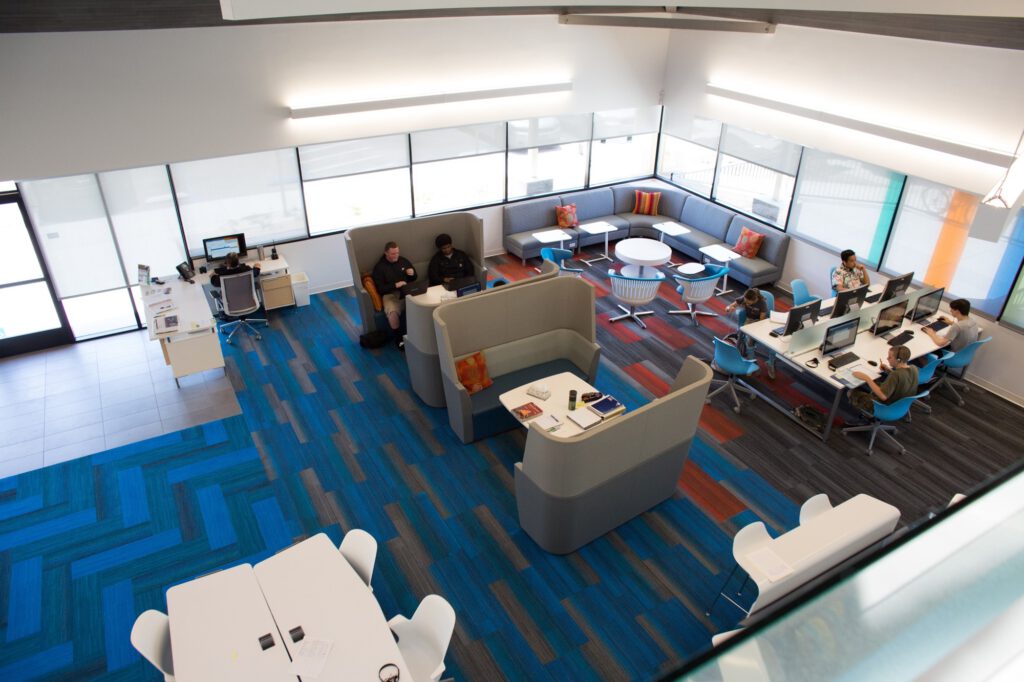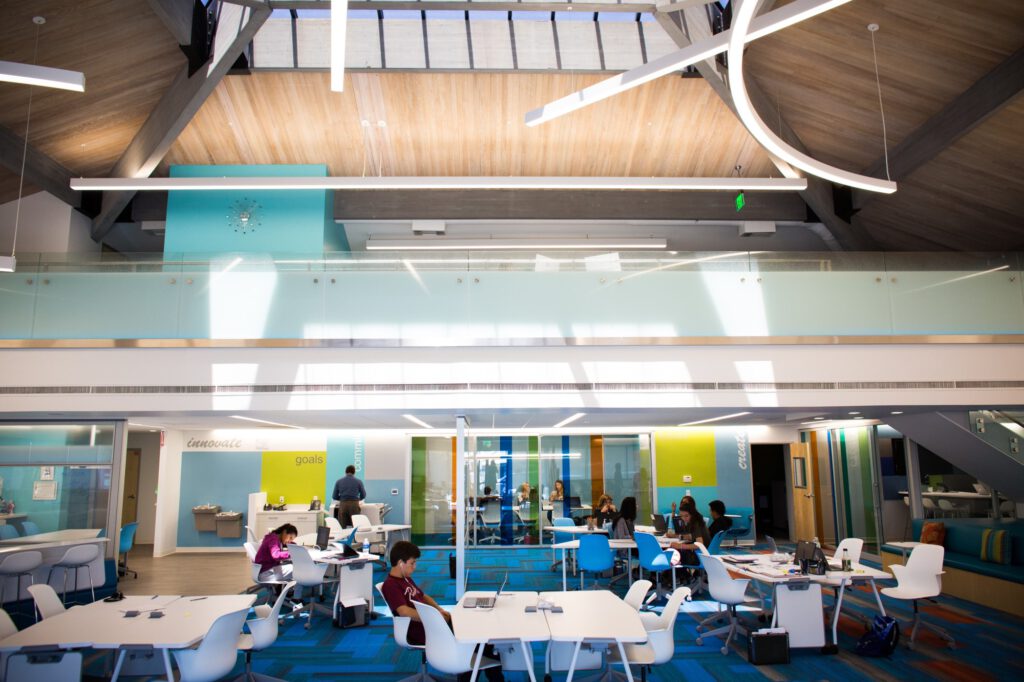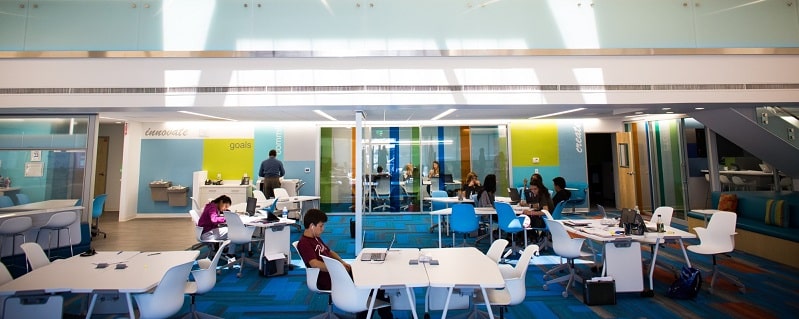As I stepped out of the San Diego sunshine and into the school located in a storefront in a strip mall, I didn’t know what to expect. I’ve visited several schools located in storefronts over the years, but few that were also charters.
My jaw dropped. The facility was unlike any school I had been in before.
It was pristine, orderly, and inspiring. This was a place where anyone would want to work—a professional adult or a student—in stark contrast to most school classrooms. It reminded me of a mix of an airy Apple Store and a coffee shop.

There was no classroom space per se, but instead the open floor plan was divided in subtle ways into a variety of well-thought-out types of spaces—from those dedicated to individual work to other spaces for small-group and one-on-one work; and from small breakout rooms for seminars to still other spaces tucked away for students to embark on virtual reality experiences, design for 3D printers, or do science labs.
Teachers had their offices upstairs. When they were downstairs, they were exclusively focused on the students.

The school I was visiting was The Charter School of San Diego, which itself has a total of 14 different resource centers across San Diego. The school is one of seven Altus Schools in California.
The schools collectively serve roughly 8,000 students per year, 70% of whom are minority students, 70% of whom identify as socioeconomically disadvantaged, and 20% of whom have disabilities. The schools largely outperform their district counterparts on various achievement measures. Fewer than 2% of students drop out, and the schools boast a 0% expulsion rate.
A 2015 Malcolm Baldrige National Quality Award recipient, which is the nation’s highest Presidential honor for performance excellence through innovation, improvement, and visionary leadership (and had never been given to an individual school before), the Charter School of San Diego and the Altus team thrive on data and a commitment to setting and realizing goals each year—and from my perspective, it’s one of the better-kept secrets in education circles.
The educators in the school, I learned, have a strong commitment to personalizing learning for each student, as the children who arrive at its doorstep each arrive with a unique story and set of needs.
Unlike traditional schools, each student is assigned to one teacher who guides the student through all of her work. In similar fashion to Colorado College, a competency-based higher education institution, students focus on one to two classes at a time and complete each course within three to four weeks—a concept that more traditional high schools should pilot, in my opinion, so that students can apply themselves more deeply—and which might pair nicely with flipping the school day.
Students do the work through a mixture of textbooks and online learning, and, similar to college, complete roughly 80% of their work at home and 20% inside the resource center. According to the school, each student develops a custom schedule with her teacher and family and will typically spend two to three days at a resource center each week for three to four hours a day.
My questions turned to curriculum. What did the school use? The answer was a mix of home-developed content and Edgenuity, among other tools.
My eyebrows raised at the mention of Edgenuity. Edgenuity is a well-known provider of online courseware and helped power some of the early darlings of the blended-learning world, such as Carpe Diem.
But the company has also come under scrutiny over the past year and a half as the media spotlight has shone unfavorably on districts’ credit recovery practices in boosting graduation rates. A common story in the media is of the student who had previously failed a course retaking it on Edgenuity only to magically complete it in mere minutes and recover the credit en route to graduation. Stories of students taking the exact same assessment with the same exact questions multiple times abound, as do stories of students simply looking up the answers on their cell phones in an effort to “achieve” the score necessary to “demonstrate mastery” and move on to the next unit.
So, I asked the teacher giving me the tour, how did he know his students using Edgenuity were really doing—and mastering—the work?
The answer is a series of redundancies that Altus Schools has put in place.
The teachers themselves are constantly checking to make sure students have done and actually understood the work. This isn’t a school where students largely work independently with little interaction with teachers.
Altus also deploys objective assessments in Illuminate, which are separate from the assessments in Edgenuity and are taken on-site in proctored settings.
And Altus also uses NWEA’s benchmark assessments to keep a close eye on student growth throughout the year in English Language Arts and mathematics. If students were gaming the system, the teacher said, the teachers would know.
The Altus Schools are hardly a finished product. They seek to improve continuously, with current goals focused on increasing academic achievement in English and math; refining measures of evaluating English Language Learner progress and proficiency; improving and increasing supports, services, and resources for student groups; and working with its disadvantaged populations to close the achievement gap.

But I left the visit impressed. Of all my school visits in the past this year, this school stood out as a thoughtful and unique design in the landscape of schools seeking to tailor learning for each individual’s distinct needs.
And I left wishing that all schools using online credit recovery would put the same thought into their systems of assessment that Altus has, so that online learning wouldn’t just be an escape valve to meet a narrow definition of success in terms of graduation rate, but instead an innovation poised to transform all of schooling by helping deliver the right learning experience each student needs at the right time.



